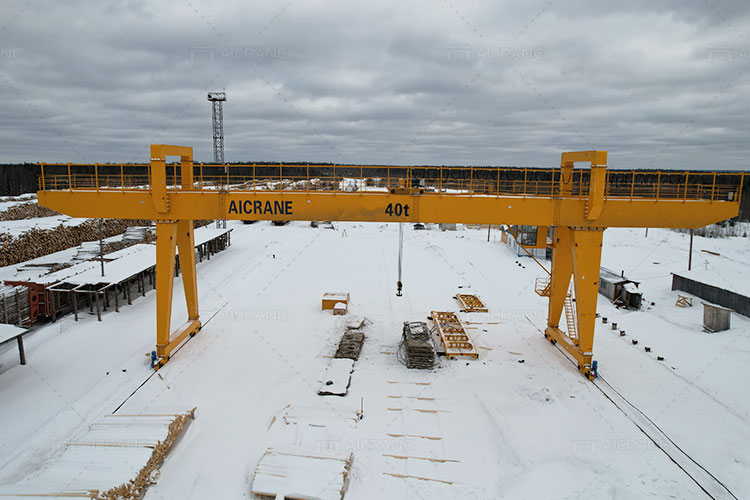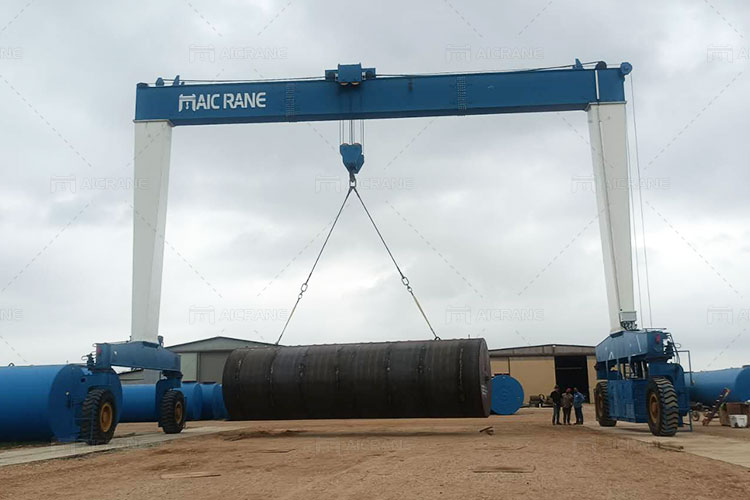When it comes to heavy lifting in industrial and construction environments, a 40-ton gantry crane is often the ideal solution. These cranes are designed to handle substantial loads and can be used in a variety of settings, from warehouses to construction sites to shipping yards. However, one of the key decisions when choosing the right gantry crane is whether to opt for a mobile gantry crane or one that runs on rails. Both have distinct advantages and drawbacks, and understanding these differences is crucial for making the right decision for your business or project needs. In this article, we will delve into the features, applications, and considerations for both mobile and rail-mounted gantry cranes, ultimately helping you make an informed decision.

Understanding Gantry Cranes: A Quick Overview
A 40 ton gantry crane consists of a bridge supported by two legs that run along tracks or rails. The crane’s lifting mechanism (hoist) moves along the bridge, allowing it to lift and transport heavy materials. The key differentiating factor between mobile gantry cranes and rail-mounted gantry cranes lies in their mobility. Mobile cranes are designed with wheels, offering the flexibility to move around a job site, while rail-mounted cranes are fixed in place and typically follow a track, which can be permanent or semi-permanent.
Key Factors to Consider When Choosing a 40-Ton Gantry Crane
1. Mobility and Flexibility
Mobile Gantry Cranes:
-
Highly Mobile: As the name suggests, mobile gantry cranes can be moved from one location to another. This makes them ideal for projects that require movement across a large site or different worksites. If you need a crane that can easily relocate to different spots, a mobile gantry crane is a great choice.
-
Limited Track System: Mobile cranes don’t require the installation of tracks or rails, which means less groundwork and a faster setup. This can be beneficial in temporary or changing environments like construction sites, where moving the crane around frequently is necessary.
-
Best for Smaller, Less Permanent Installations: If your project doesn’t have a long-term need for the crane, a mobile gantry crane could be more practical, saving you the time and cost associated with rail installation.
Rail-Mounted Gantry Cranes:
-
Fixed Location: These cranes are ideal for facilities where lifting needs are predictable and constant, such as container yards, large manufacturing plants, or steel mills. Once installed, rail-mounted cranes typically remain in one location, providing reliable lifting capacity for routine tasks.
-
Precision in Movement: A rail-mounted crane offers a high degree of precision when moving heavy materials along the track. The ability to position materials exactly where needed is particularly valuable in operations requiring tight tolerances, such as in precast concrete production or shipping and receiving facilities.
-
Limited Flexibility: Once the rail system is installed, you cannot easily move the crane. This makes rail-mounted cranes less flexible compared to mobile models.

2. Cost Considerations
Mobile Gantry Cranes:
-
Lower Initial Investment: Mobile cranes generally have a lower upfront cost because they don’t require a rail system. They are ready to use as soon as they are set up, making them more cost-effective in terms of installation.
-
Operational Costs: While the initial cost of gantry crane is lower, the operational costs could be slightly higher in the long run due to wear and tear from constant movement, as well as the need for frequent maintenance of the wheels and mobile base.
Rail-Mounted Gantry Cranes:
-
Higher Initial Cost: The installation of rail-mounted cranes comes with a higher upfront cost due to the need to lay down tracks or rails, which requires both time and financial resources. The track system itself also needs to be constructed to withstand the weight of the crane and its load.
-
Lower Maintenance Costs: Rail-mounted cranes generally incur lower maintenance costs over time because there are fewer moving parts (no wheels or tires) and the track system remains fixed in place.
3. Site Conditions and Space Availability
Mobile Gantry Cranes:
-
Adaptable to Various Site Conditions: Mobile cranes are perfect for environments where track installation isn’t feasible, or where the ground is uneven, such as outdoor construction sites, quarries, or areas with limited infrastructure.
-
Space Efficiency: Because mobile cranes don’t require extensive groundwork or rails, they are ideal for sites where space is at a premium or where the crane needs to operate in a compact area.
Rail-Mounted Gantry Cranes:
-
Ideal for Large, Permanent Sites: Rail-mounted cranes are best for large sites with established infrastructure. These rail gantry cranes are ideal for facilities like shipyards, steel mills, or container terminals, where the crane will remain in the same location for a long time.
-
Requires Significant Space for Tracks: Installing a rail system requires space for the tracks and the crane’s operating area. This setup is not as flexible as mobile cranes and might not be suitable for smaller or temporary spaces.
4. Lifting Capacity and Performance
Mobile Gantry Cranes:
-
Suitable for Moderate Lifting Capacities: While mobile gantry cranes can be equipped to lift 40 tons, they are typically more suitable for handling moderate loads over relatively short distances.
-
Lower Speeds and Precision: Mobile cranes can handle the load capacity well, but their lifting speeds and the precision of their operations may not be as high as rail-mounted cranes.
Rail-Mounted Gantry Cranes:
-
High Performance and Precision: Rail-mounted cranes are designed to handle heavy-duty lifting tasks efficiently and precisely, making them perfect for environments that require continuous heavy lifting, such as container loading and unloading.
-
Faster and More Stable: Rail-mounted cranes offer greater stability and can handle larger and more complex operations. They can be used for high-speed lifting and moving of large volumes of goods over long distances within the facility.
5. Safety Considerations
Mobile Gantry Cranes:
-
Safety in Dynamic Environments: Mobile cranes are designed to move with the crane operator being actively involved. The risk of accidents can increase if not operated properly in dynamic environments. Ensuring the crane is regularly maintained and safely operated is essential.
-
More Vulnerable to Movement Issues: In some cases, mobile gantry cranes can be less stable than their rail-mounted counterparts, particularly if the ground surface is not level or the crane is overloaded.
Rail-Mounted Gantry Cranes:
-
High Stability: Rail-mounted cranes are more stable because they follow a fixed track. Their predictable movement and fixed structure allow for safer operations, particularly in areas with heavy-duty lifting.
-
Less Risk of Accidents: Since rail-mounted cranes are designed to operate on tracks, they typically face fewer issues with accidents caused by sudden movements or unstable ground conditions.
Conclusion: Which One is Right for You?
Choosing between a mobile and rail-mounted gantry crane ultimately depends on the specific needs of your project or business. Here’s a quick summary of when to choose each:
-
Choose a Mobile Gantry Crane if:
-
Your lifting needs are more flexible or temporary.
-
You need the ability to move the crane across different sites.
-
Your budget for installation and track systems is limited.
-
The crane will operate in a dynamic or changing environment.
-
-
Choose a Rail-Mounted Gantry Crane if:
-
You require a fixed crane for continuous, heavy-duty lifting operations.
-
Your site has the space and infrastructure to accommodate a rail system.
-
High precision and speed are essential for your operations.
-
Long-term, high-frequency lifting is a priority.
-
Both options come with their own sets of advantages. By considering factors such as mobility, cost, space, lifting requirements, and safety, you can select the right 40-ton gantry crane that best fits your business’s needs.